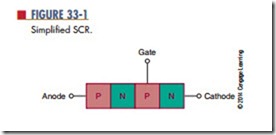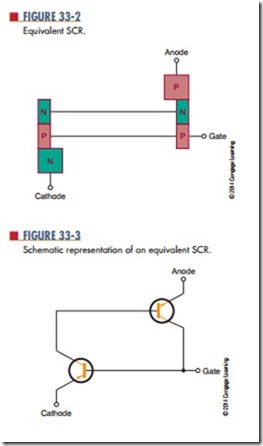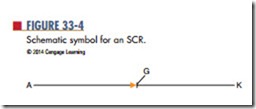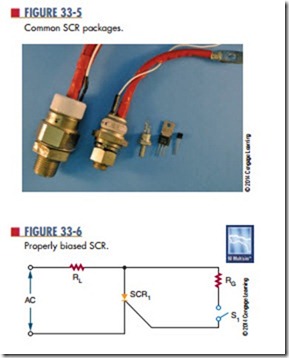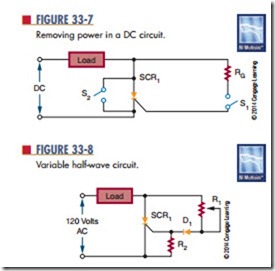Thyristors are widely used for applications where DC and AC power must be controlled. They are used to apply power to a load or remove power from a load. In addition, they can also be used to regulate power or adjust the amount of power applied to a load—for example, a dimmer control for a light or a motor speed control.
Silicon-controlled Rectifiers
Silicon-controlled rectifiers are the best known of the thyristors and are generally referred to as ScRs. They have three terminals (anode, cathode, and gate) and are used primarily as switches. An SCR is basically a rectifier because it controls current in only one direction. The advantage of the SCR over a power
transistor is that it can control a large current, dependent on an external circuit, with a small trigger signal.
An SCR requires a current flowing to stay turned on after the gate signal is removed. If the current flow drops to 0, the SCR shuts off and a gate signal must be reapplied to turn the SCR back on. A power transistor would require 10 times the trigger signal of an SCR to control the same amount of current.
An SCR is a solid-state device consisting of four alternately doped semiconductor layers. It is made from silicon by the diffusion or diffusion-alloy method. Figure 33-1 shows a simplified diagram of an SCR. The four layers are sandwiched together to form three junctions. Leads are attached to only three of the layers to form anode, cathode, and gate.
Figure 33-2 shows the four layers divided into two 3-layer devices. They are a PNP and an NPN transistor interconnected to form a regenerative feedback pair. Figure 33-3 shows the schematic symbols for these transistors. The figure shows that the anode is positive with respect to the cathode, and the gate is open. The NPN transistor does not conduct because its emitter junction is not subject to a forward-bias voltage (provided by the PNP transistor’s collector or gate signal). Because the NPN transistor’s collector is not conducting, the PNP transistor is not conducting (the NPN transistor’s collector provides the base drive for the PNP transistor). The circuit does not allow cur- rent to flow from the cathode to the anode under these conditions.
If the gate is made positive with respect to the cathode, the emitter junction of the NPN transistor
becomes forward biased and the NPN transistor conducts. This causes base current to flow through the PNP transistor, which in turn allows the PNP transistor to conduct. The collector current flowing through the PNP transistor causes the base current to flow through the NPN transistor. The two transistors hold each other in the conducting state, allowing current to flow continuously from the cathode to the anode. This action takes place even though the gate voltage is applied only momentarily. The momentary gate voltage causes the circuit to switch to the conducting state and the circuit to continue conducting even though the gate voltage is removed. The anode current is limited only by the external circuit. To switch the SCR off, it is necessary to reduce the anode-to-cathode voltage below the hold-on value, typically close to 0. This causes both transistors to turn off and remain off until a gate voltage is again applied.
The SCR is turned on by a positive input gate volt- age and turned off by reducing the anode-to-cathode voltage to 0. When the SCR is turned on and is Common SCR packages.
conducting a high cathode-to-anode current, it is con-ducting in the forward direction. If the polarity of the AC cathode-to-anode bias voltage is reversed, only a small leakage current flows in the reverse direction.
Figure 33-4 shows the schematic symbol for an SCR. This is a diode symbol with a gate lead attached.
The leads are typically identified by the letters K (cathode), A (anode), and G (gate). Figure 33-5 shows several SCR packages.
A properly biased SCR is shown in Figure 33-6. The switch is used to apply and remove gate voltage. The resistor RG is used to limit current to the specified gate current. The anode-to-cathode voltage is provided by the AC voltage source. The series resistor (RL) is used to limit the anode-to-cathode current to the specified gate current when the device is turned on. Without resistor RL the SCR would conduct an anode- to-cathode current high enough to damage the SCR.
SCRs are used primarily to control the application of DC and AC power to various types of loads. They can be used as switches to open or close circuits. They
can also be used to vary the amount of power applied to a load. In using an SCR, a small gate current can control a large load current.
When an SCR is used in a DC circuit, there is no inexpensive method of turning off the SCR without removing power from the load. This problem can be solved by connecting a switch across the SCR (Fig- ure 33-7). When switch S2 is closed, it shorts out the SCR. This reduces the anode-to-cathode voltage to 0, reducing the forward current to below the holding value and turning off the SCR.
When an SCR is used in an AC circuit, it is capable of conducting only one of the alternations of each AC input cycle, the alternation that makes the anode posi- tive with respect to the cathode. When the gate current is applied continuously, the SCR conducts continu- ously. When the gate current is removed, the SCR turns off within one-half of the AC signal and remains off until the gate current is reapplied. It should be noted that this means only half of the available power is applied to the load. It is possible to use the SCR to control current during both alternations of each cycle. This is accomplished by rectifying the AC signal so
that both alternations of each cycle are made to flow in the same direction before being applied to the SCR. Figure 33-8 shows a simple variable half-wave cir- cuit. The circuit provides a phase shift from 0 to 90 electrical degrees of the anode voltage signal. Diode D1 blocks the reverse gate voltage on the negative half-cycle of the anode supply voltage.
Questions
1. Why is an SCR considered better for switching than a transistor?
2. Describe how an SCR is constructed.
3. Explain how an SCR operates.
4. Draw and label the schematic symbol for an SCR.
What are some applications of an SCR?
